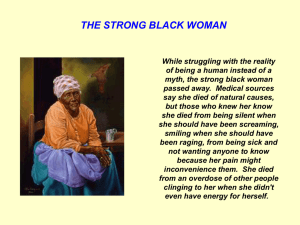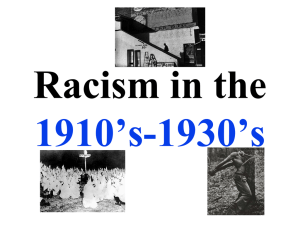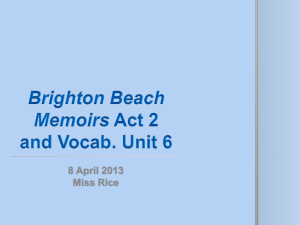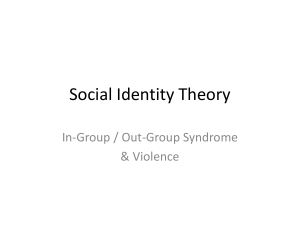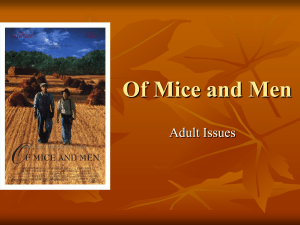Anti-Racism-Training..
advertisement
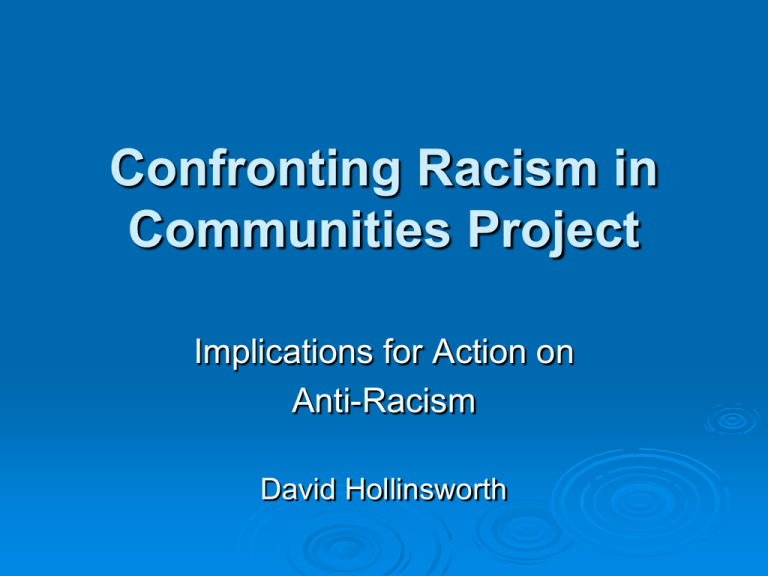
Confronting Racism in Communities Project Implications for Action on Anti-Racism David Hollinsworth Overview of the Final Report findings and Implications About the Confronting Racism in Communities Project Project Methodology Project Findings: Racist Incidents Discussion and analysis How to Identify Racism from Incidents Gaps in Strategies What works (and what doesn’t) How to respond to exclusion in our organizations How to support and assist workers in countering racism Racialization and the role of politics and the media Conclusion and future directions What is the Confronting Racism in Communities Project? The project aims to address the variety of racisms experienced by culturally and linguistically diverse (CALD) communities in Queensland. What is the Confronting Racism in Communities Project? Project consortium lead by Centre for Multicultural Pastoral Care Three-year pilot project extended to four State-wide Funded by Multicultural Affairs Qld Reference Committee Project Objectives 1. Provide support, training and resources to the community sector in order to combat racism. 2. Work with communities to document the nature and extent of racism in Queensland and provide regular reporting on incidents across the state. Why Anti-Racism Training? Developed Racism Training Needs Survey focusing on workers’ experience with racism and on their training needs. Completed by 50 individuals from multicultural, mainstream and government agencies in metropolitan and regional Queensland. Produced Racism Training Strengths & Needs Analysis. Key Findings of needs survey 72% of respondents felt issues of racism were “very relevant” to their work, while 16% of respondents felt issues of racism were “somewhat relevant” to their work. 26% of respondents reported they were “not very well equipped/skilled” to support clients who had experienced racism, while 8% reported they were “not at all equipped/skilled”. 34% of respondents said they had previously participated in anti-racism training. BUT….. Key Findings 8% of respondents said their organisation had funds allocated for anti-racism training. Respondents said they would find the following training options beneficial: - Community development responses to racism - Supporting people who have experienced racism - Identifying racism - Racism in the workforce - Working with the media Why we need to collect Data on Racism in Communities? To help us better understand & respond to the needs of people from CALD backgrounds. So we can demonstrate that racism is a significant issue that needs to be addressed in the face of government denial. Because there is currently very little data on racism in Queensland. To highlight the diversity of geography of racism; different places, forms and targets. How was Data on Racism Collected? Racist Incident Reporting Form 70 Data Collection Points throughout Queensland Bi-annual reports on the nature and extent of racism in Queensland Reports highlight general trends - they do not disclose identifying information Indigenous reports not asked for as directive from MAQ Findings: how many and where? 398 racist incidents reported between January 2006 to December 2007 37% occurred in Brisbane region; 15% in Logan; 13% Gold Coast; 11% Sunshine Coast; 7% Toowoomba; 5% Cairns; 4% Townsville; 3.5% Mackay; 2% Wide Bay and Rockhampton. Findings: who was targeted? India, Pakistan, Sri Lanka, Bangladesh 16.6% (66) China, Taiwan, Hong Kong 13.0% (53) Other Asian 6.8% (27) Sudan 9.8% (39) Other African 10.8% (43) Arabic Speaking 7.8% (31) Other Middle East, Near East 4.5% (18) Pacific Islander 6.0% (24) Latin America 3.8% (15) European 5.0% (20) Anglo Australian (Muslim, Buddhist, other) 4.3% (17) Indigenous** 1.5% (6) Not Specified 9.8% (39) Total 100% (398) Findings: types of incident Physical violence 17% Threat of physical violence 6% Property damage 4.5% Verbal harassment 49% Non-verbal harassment 10% Written harassment 3% Racist graffiti 5.5% Offensive media content 3.5% Social exclusion 9% Discrimination 39% Institutional racism 20% Findings: location of incident On the street 16% At work 14% At school or university 9% At home 4% Renting or applying to rent 12% In private vehicle 2% Public transport 11% Shop or supermarket 11% Social venue 4% Place of leisure 2% Letter or phone call 3% Media 3% Government departments 5% Other 4% Responses to racist incidents Anger Upset Scared Anticipation Anxious or distressed Feeling of exclusion, not belonging Personal growth, resilience Sadness Disturbed or depressed Isolated Lack of confidence, helpless, victim Physical reaction Shame Reporting of racist incidents Reported to authorities 19% Not reported 70% Not specified 11% Satisfaction with results of reporting Very satisfied Satisfied Neutral Unsatisfied Very unsatisfied Not specified 4% 16% 8% 45% 21% 6% What is racism and how does it impact on us, our families and friends, and our work? Since racist incidents affect a group as well as an individual, they are experienced as attacks on the values, loyalties and commitments central to a person’s identity and self-worth – their family honour, friends, cultural heritage, religion, community and history. Racist, cultural and religious abuse is accordingly more hurtful than any or most of other kinds of abuse. Bristol City Council (2004) Reporting and Dealing with Harassment in Bristol Schools, available from: http://www.bristol-cyps.org.uk/services/pdf/racial_abuse.pdf The street as a site for racism The physical site of racism is often the street. In the 2006 national study on refugee settlement by USC and VU, approximately 25% of newly arrived refugees reported daily, weekly or monthly experiences of racism – significant proportion on the street. 16% of racist incidents reported to the Confronting Racism in Communities Project occurred on the street. In a study by Poynting et al, 58% identified racism, abuse or violence that took place on the street. Women were more likely to experience racism on the street (62%) than men (50)%. Spaces of fear and incivility. Poynting S. & Noble G. (2004)Living with Racism: The experience and reporting by Arab and Muslim Australians of discrimination, abuse and violence since 11 September 2001, HREOC, Sydney Examples: Types of Incidents in the Street Gazing/Staring – ‘oppression of the eyes’ Verbal abuse Physical abuse or violence Threats of violence Harassment Hand gestures (eg.sexual, mimicking guns) Analysis: Personal Consequences Fear of public spaces Withdrawal – lack of access to essential services and resources Reluctance to engage Sense of isolation and not belonging Sense of helplessness Physical and mental health consequences, can be cumulative and chronic Settlement consequences for newly arrived migrants and refugees For refugees, can compound trauma Analysis: Social Consequences Control of national/public spaces Fear – inward looking, society lacking in compassion Diminishing social capital (trust, reciprocity, networking) Lack of belonging Loss of human potential Lack of representation of minorities in public arena Gaps in Strategies Legislative changes: systemic racism; indirect discrimination; punitive rather than conciliatory approach from AHRC and ADCQ. Inclusion of religious discrimination under federal RDA Positive Duty as in UK to eliminate unlawful racial discrimination; whole institutional approach with sanctions for managers Explicit anti-racism campaigns not just celebrating diversity and ‘harmony’ projects Effective media campaigns to rebut myths and promote human rights What Works (and what doesn’t) Leadership: government, opinion leaders, media and activists Avoidance of culturalism and essentialism (even when applied to reverse racist beliefs) Highlighting shared commonalities (not sameness but intersecting parallels) rather than stark or inherent differences Building community capacity for resilience and self-advocacy including skills with media Identifying (covert) racism within institutions and dominant ideologies, not just isolated incidents What Works Strategies for inclusion and accountability, not just getting a CALD person on the board Community activities that are safe, shared, equal status and control between groups, common goal with official support and credibility Avoid ‘preachy’ or guilt inducing approaches that cause denial and resistance Document and publicize successful activities Evaluate and conduct research to identify unintended exclusions and appropriate countermeasures How to Respond to Exclusion in our Organisations Identification of Institutional Racism Strategies for Inclusion Forms of Racism Different levels or forms of racism: individual or personal racism (insults, harassment and discrimination directed at individuals) institutional or systemic racism (conventional practices or structures and processes of institutions that have the effect of excluding or discriminating against individuals or groups) cultural racism ( beliefs, stories and assumptions that naturalize social inequality as caused by inherent characteristics of the disadvantaged eg. dysfunctional families or poor choices, and/or universalize dominant values or hide privileges) Intended or unintended racism Racism can be present in hostile acts, as well as in apparently neutral or mundane arrangements. It can be the result of activities or arrangements that set out to discriminate or harm, or it can result from ignorance or inadvertence or lack of awareness. Thus, racism can be intentional or unintentional; it may however be detected by its effects (need data). Defining Institutional Racism The collective failure of an organization to provide an appropriate and professional service to people because of their colour, culture or ethnic origin. It can be seen or detected in processes, attitudes and behaviour which amount to discrimination through unwitting prejudice, ignorance, thoughtlessness and racist stereotyping which disadvantage Black and minority ethnic people. Macpherson W (1999) The Stephen Lawrence Inquiry: Report of an Inquiry by Sir William Macpherson of Cluny (Cm 4262), London, The Stationary Office. Interplay between institutional and cultural racisms Institutions validate rules, roles and certain understandings about entitlements which are often seen as fair or universal, but which actually reflect and protect dominant social interests – through, for example, understandings about who is a good parent, a reliable tenant or borrower, or the best for the job. But these rules are not applied mechanistically or deterministically. They are activated by bureaucrats, social workers, receptionists and so on, whose own perceptions, priorities and values are fused with cultural meaning that speak of their own personal histories and social location. Within particular constraints and in their own ways, they ‘do their job’. Pettman, Jan (1992) Living in the Margins: Racism and Feminism in Australia, Allen & Unwin, St Leonards, New South Wales. Key Issues Institutional racism is not always explicit, as in the 19th or 20th century – often covert. May be unintentional – This form of racism reflects the cultural assumptions of the dominant group, so that the practices of that group are seen as the norm to which other cultural practices should conform. Resulting from universality of treatment. Treating everyone the same does not equate to fairness and equity – substantive equality requires different treatment (Charles Husband 2004). Institutional Power The core of the concept of institutional racism is the irrelevance of the intentions of the actors involved. Need to look at institutional power, practices and responsibilities: - Where the power lies in institutional structures. - Points in the institution where people are able to exercise discretionary power – to make decisions, set rules and allocate resources. - Ways in which these rules and norms are legitimated. - Ways in which they produce discriminatory outcomes. Institutional racism begins to enter into practice when institutional routines reflect the interests of only one group, usually the majority. Unpacking Institutions Professional identities, roles and their boundaries Institutional processes and routines: Organisation of work spaces Times Resources Policies Procedures Level/type of staffing Power relationships between staff Decision making processes Governance arrangements Advisory-consultative mechanisms Management ideologies: cost saving, efficiency. Responding to Exclusion Changing occupational culture. Policy and planning. Employment – recruitment and selection, retention, training, grievance and disciplinary, appraisal. Service delivery and customer care. Consultation, partnerships and multi-agency work. Communication, information, marketing and corporate image. Leadership. Accountability and transparency. How can we support and assist each other to combat racism in our communities? Racialization Racialization: discursive process of “racing”, of imposing racial meanings to an individual or group Examples include “dysfunctional” Aboriginal people or “queue-jumping” asylum seekers or “oppressed” Muslim women or Islamic “terrorists” Essentializes negative stereotypes as inherent or fixed racial characteristics Racialization and politics Often used by politicians to pander to populist fears and hatreds But this use entrenches such beliefs and encourages violent and abusive behaviors “Violent racists are always a tiny minority. However, their breathing space is determined by the degree of ‘ordinary’ non-violent racism a government and culture will allow” (Hage, 2003: 247) Racialization and media Media: key source of racialization, fear, anxiety, threat and hostility Examples especially in crime reporting, international and non-state conflict such as terrorism and civil war Strategies to combat media racism: complaints, right of reply, advocacy stories, media skills training, community media and arts projects, social networks and interNet




